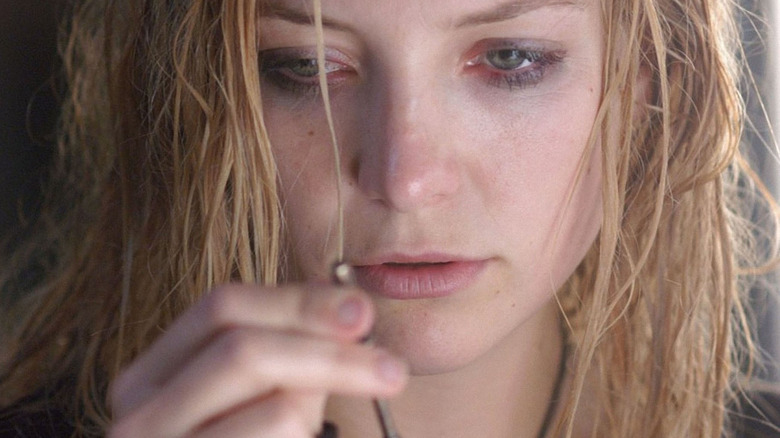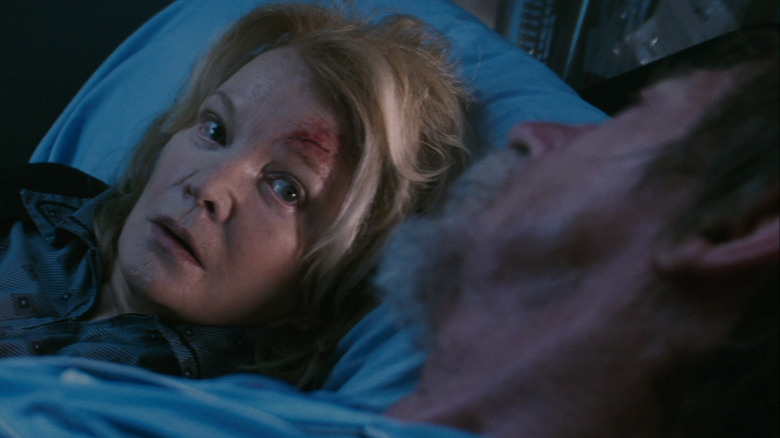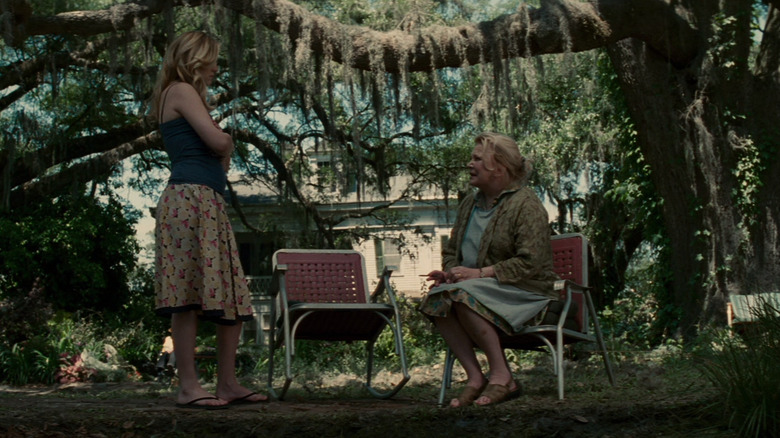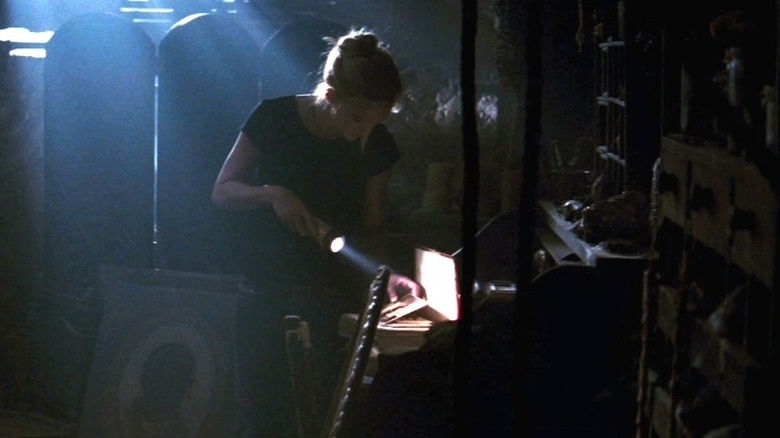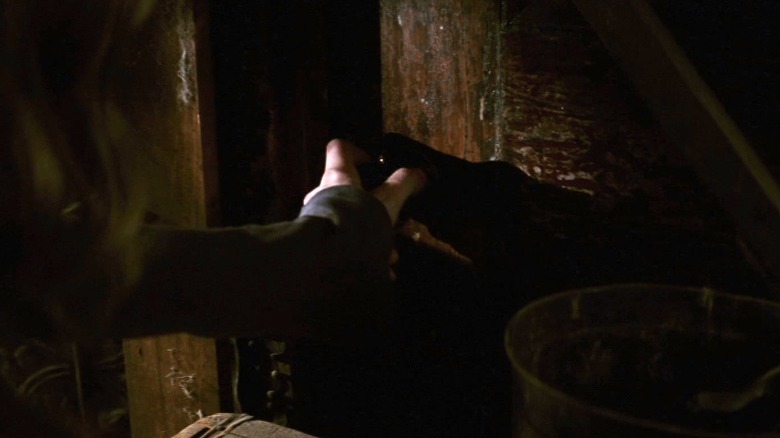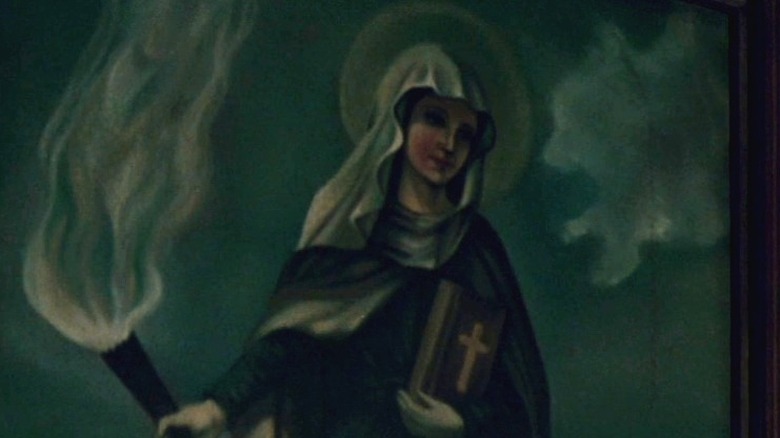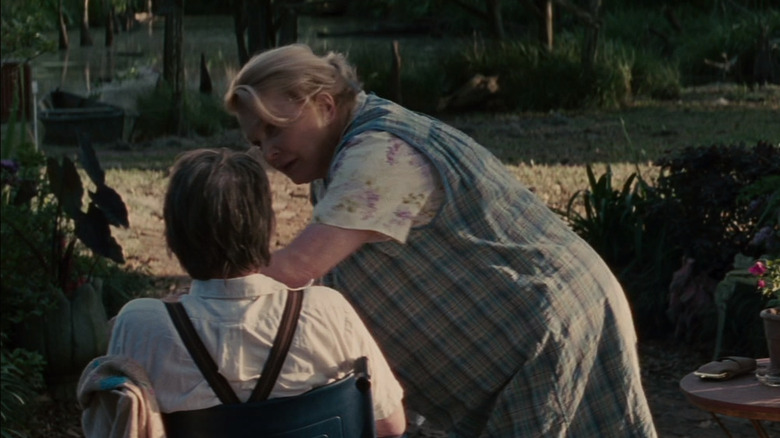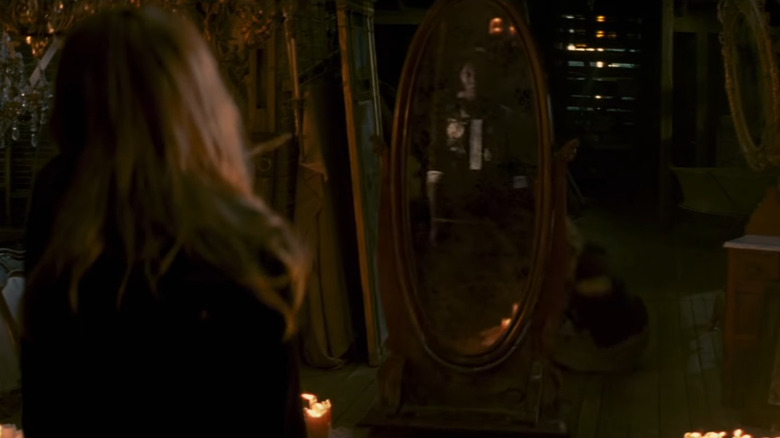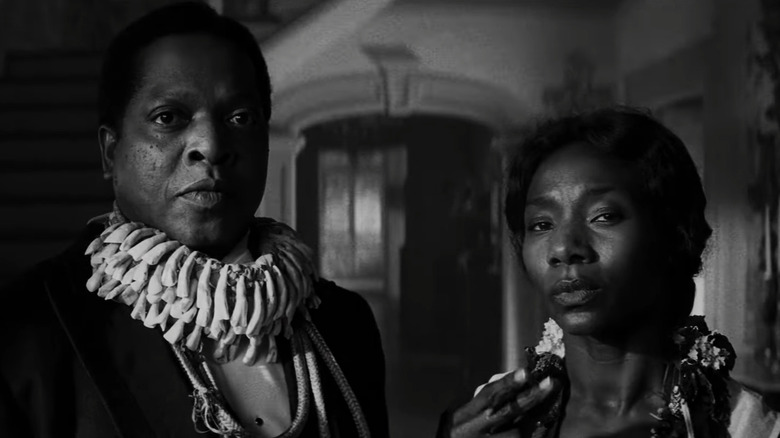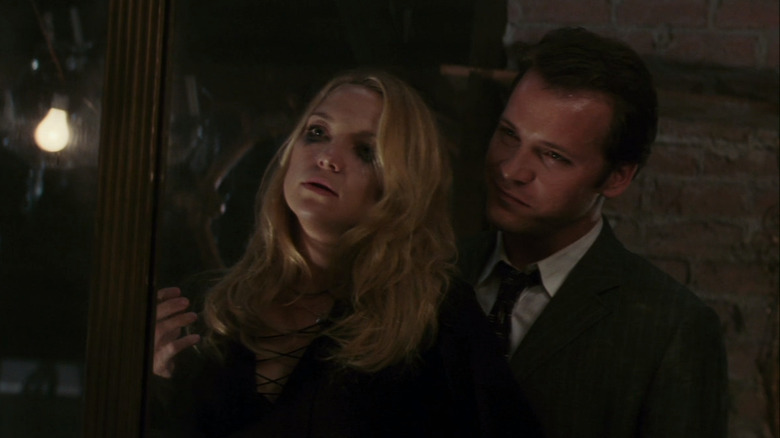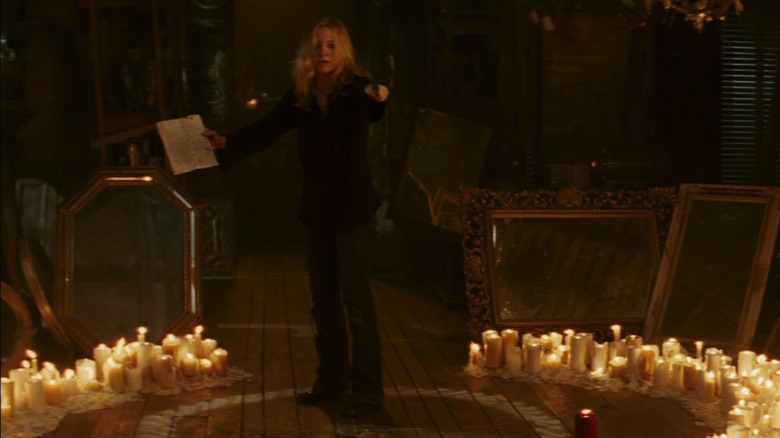The Skeleton Key Ending Explained
Moody and atmospheric, 2005's "The Skeleton Key" is a low-key supernatural horror movie that masquerades as a psychological thriller for most of its runtime. Kate Hudson plays Caroline Ellis, a hospice worker who grows dissatisfied with her job and answers an ad in the paper to be a live-in caretaker for the Devereauxs — Violet (Gena Rowlands) and her husband, Ben (John Hurt). Ben had a stroke that paralyzed both sides of his body, rendering him unable to talk and leaving him at death's door.
But the Devereauxs' lushly isolated swamp plantation is unsettling from the start, and Violet's cantankerous evasiveness arouses Caroline's immediate suspicion. Something happened to Ben that she's not been told, and Caroline is determined to find out what. It's a film with so many layers of deception and misdirection that it can be hard to separate the truth from the lies even when they're right in front of your face. The viewers only become aware of its genre-straddling elements as Caroline does, and most of that's reserved for the final act. And just when Caroline and the rest of us feel like we have it all figured out, everything is turned on its head.
As Hurt said in a 2005 interview with Brulik Entertainment, "What I liked about it was it was such an unusual premise. And such an unusual ending, particularly for Hollywood." But while that bleak ending may feel like it comes out of nowhere, it's telegraphed from the start.
Caroline is trapped — body and soul
While many (but certainly not all) horror movies settle on happy endings in which the villains are vanquished and the hero walks away, "The Skeleton Key" isn't one of them. Unless, of course, you were rooting for Mama Cecile (Jeryl Prescott) and Papa Justify (Ronald McCall), who have a twisted scheme to inhabit younger bodies and bypass the aging process. In fact, when you get down to it, the ending is horrifying. Luke (Peter Sarsgaard) has long been a lost cause, as he'd been taken and shunted into Ben's body before the film ever started — Justify masquerades as him for the entire movie.
Hoodoo only works if you believe, and over the course of the film, Caroline allows herself to be drawn in until she believes enough for Cecile to hop out of Violet's body into hers. Cecile's days of youth are over, and after the transfer is done, Caroline in Violet's body is given the same paralytic potion "Ben" had been taking the whole movie. And in Caroline's desperate attempt to escape, she broke both of Violet's legs, so she inherits a broken body. In addition, the story of Violet falling down the stairs helps make the case that both she and Ben need to be locked away in a nursing home.
In the end, we realize that every time Caroline thought she was uncovering secrets and fighting back, she was just falling deeper down the rabbit hole. Nearly everything she'd been through was staged, planned, and executed almost without a hitch in order to make her believe in Hoodoo so her body could be taken from her.
Violet actually turns out to be pretty honest
When all is said and done, perhaps the biggest surprise is how honest Violet — or rather, Mama Cecile in Violet's body — is throughout the film. When Caroline wants to know about the room in the attic with all the Hoodoo paraphernalia, Violet tells her that it belonged to Cecile and Papa Justify — and that the house still belongs to them. And it does — their bodies are long gone, but their ghosts are still around, body-hopping, passing the house down through their victims.
Violet then tells the tale of Cecile and Justify's lynching and how they were caught in the attic with their employer's children performing a Hoodoo ritual. That definitely happened — she just leaves out the (admittedly important) detail that the ritual swapped souls. Then there's Ben. Though Violet first claims he had a stroke in the attic, Caroline pushes for the truth, and she amends her story. Actually, Violet says, he was attacked by ghosts in the attic, and they left him paralyzed. And, really, that's what happened. As we see with Caroline, everything needed to perform the Conjure of Sacrifice is in the attic. That's probably where the ghosts of Cecile and Justify in their stolen bodies first snatched Ben, and more recently, Luke.
Violet doesn't hold much back. She just acts as if she's reluctant to share, and that makes Caroline think she's digging into the truth and learning about these "superstitions" on her own. It's masterfully, horrifyingly manipulative.
The symbolism of the skeleton key
Manipulation, it turns out, is key when it comes to stealing a body. In order for the Conjure of Sacrifice to work, Caroline needs to believe in it and the Hoodoo behind it. But that's a tall order for anyone grounded in reality. People don't just believe in something because they're told to. In fact, telling people to believe is a good way to get them to dig in and push back at you. But if they think they came to the conclusion you want on their own, well, that's different.
This isn't Mama Cecile and Papa Justify's first body snatching, and they understand that Caroline has to come to believe in Hoodoo on her own. Violet can't simply tell her magic is real, and this is where the skeleton key comes in. In particular, it gives Caroline unfettered access to the house, allowing her to explore and stumble upon her own discoveries. It's symbolic of the way she explores the world of Hoodoo, stumbling upon its secrets as she tries to find out what really happened to Ben.
At least, that's what she thinks she's doing. In reality, Violet — and to a lesser degree, Luke — expertly nudge her down every path. They pique Caroline's curiosity with "accidental" slip-ups here and there, deny her access to both the house and knowledge when necessary, and feed her just enough truth to keep her hooked.
The importance of the locked door in the attic
One place where the symbolism of the skeleton key and its literal use collide is in the locked room in the attic. Screenwriter Ehren Kruger (who burnished his horror credentials writing "Scream 3" and "The Ring") explains in "Behind the Locked Door — Making the Skeleton Key" that human beings are immediately drawn to places they can't go. If there's a locked door, we have to know what's on the other side of it. So for Caroline, Mama Cecile and Papa Justify's attic room "takes on incredible significance," says Kruger, "and becomes, effectively, the only room in the house."
It's no accident that Violet sends Caroline up into the attic to grab seeds early in the movie. Nor is it an accident that the only door in the house that won't open for Caroline is in that attic. When she finally does manage to enter, she discovers that a piece of the key had broken off in the lock, blocking her own. At the end of the movie, as Caroline goes through Luke's desk, there, nestled in the drawer, is another skeleton key, identical to her own but with the end of it broken off.
Cecile and Justify use the skeleton key, the room, and Caroline's own determination against her. Because once Caroline finds her way into that room and takes the record with the Conjure of Sacrifice, she starts tipping over from skepticism to belief. Once that happens, there's no turning back.
The film is rife with foreshadowing
Watch "The Skeleton Key" the first time, and that ending inevitably catches you by surprise. But watch it a second, and suddenly the movie is rife with hints and foreshadowing that all but reveal where it's going. For example, Jill asks Caroline early in the movie if her work is changing her, then warns her not to get sucked into her new employers' "elderly ways." By the end of the film, Caroline's been sucked in so deep that Mama Cecile has taken her body.
One of the greatest pieces of foreshadowing manages to almost perfectly encapsulate all the movie's layers. It comes when Caroline first enters the Devereauxs' house and walks past a painting of a saint holding a Bible and brandishing a torch. That's St. Martha, the patron saint of servants and housewives. At first glance, it makes sense that an Old South gal like Violet would hang it in her home. But, we learn at the end, there is no Violet — it's not her home. In reality, it's the home of the former servants, Mama Cecile and Papa Justify, so St. Martha is their saint. Except she's also known as St. Martha the Dominator, as medieval legend has it that she tamed a dragon. Because of that, she's popular to call upon in Hoodoo spells in which you seek to dominate another person. For the knowledgeable, that painting alone reveals exactly what to expect.
Who were the real Violet and Ben?
If there's one fairly consistent point of confusion, it's over who Violet and Ben are. Some viewers mistakenly believe they were the kids that Mama Cecile and Papa Justify first took over. That, though, happened 90 years ago, and Violet and Ben just aren't that old. Plus, Cecile bemoans how much harder it's gotten to get folks to believe, making it clear they've done this a couple times.
So when Violet says that she and Ben bought the house from a brother and sister back in the '60s, there's no reason to doubt her. After all, most of the rest of the history she reveals is true. Depending on how old the brother and sister were when they were taken over, they'd have been in their 50s or 60s by the time Violent and Ben came along, so their possessors were likely itching for younger bodies again.
But it was likely more complicated than what Mama Cecile reveals. Violet and Ben may have been a real couple who bought the house, but Cecile and Papa Justify selling the property and then getting them to believe enough to be taken over seems tricky. More likely, the couple was taken one at a time like Luke and Caroline, and arrangements were made to sell to one of them — much like the will was crafted to leave the house to Caroline. As to who the Deverauxs might have been before, though, that's anyone's guess.
What was with the mirrors?
One of the things that most piques Caroline's curiosity is the ban on mirrors in the house. We're never really sure why that is, though. At first, Violet shrugs it off, claiming that after a certain age, you don't really want to look at yourself anymore. It's a ridiculous explanation, but there might be a grain of truth in it since Mama Cecile and Papa Justify don't seem all that fond of inhabiting older folks' bodies.
Then, when pushed, Violet says it's because you see the ghosts of Justify and Cecile in them. Caroline thinks this is ridiculous, but when she shows Ben a mirror, he freaks out, and she assumes he believes in the ghosts. His reaction, though, might just be Luke reacting to seeing himself in Ben's body. But this explanation also seems absurd since the ghosts of Justify and Cecile aren't flitting around the house.
Except when we get to the end of the movie, the large mirror in the attic seems like an integral part of the Conjure of Sacrifice. Violet stands behind it and holds it up to Caroline, and we see it cycle through ghostly images of Violet and the young girl Mama Cecile first took over. The Conjure of Sacrifice ends when Mama Cecile's ghost appears in the mirror, and she — in Violet's body — pushes it to break over Caroline. So maybe ghosts do appear in mirrors — at least when it's time to steal a body.
Should we sympathize with Mama Cecile and Papa Justify?
When Violet tells the story of Mama Cecile and Papa Justify's lynching, it's clear they're supposed to be sympathetic victims of heinous abuse and racism. But this is before viewers really know what's going on. Afterward, it's hard to muster the same sympathy. So are they purely irredeemable villains or avenging spirits?
In "Behind the Locked Door — Making the Skeleton Key," screenwriter Ehren Kruger notes that, "All ghost stories really are about a crime in the past that is unavenged, deserves retribution." Yes, Cecile and Justify had already jumped bodies before a white mob lynched their bodies, but they still had to watch it happen. And when Violet tells their tale, she makes clear that the man they worked for was cruel. The lynching was just the culmination of his treatment of them.
Violet says that in life, Cecile and Justify "healed the sick and hurt the mean," but they were abused and worked to the bone by a vicious employer. They didn't start out bad, and what they've done to stay alive by taking over the bodies of white southern folks can certainly be looked at as retribution against a racist, abusive culture — lashing out, maybe a bit too much, to hurt the mean. But that only goes so far. When Cecile is in Caroline's body, she says she's tired of being a white woman, but they can never get any Black folk to stick around long enough. So it's clearly moved beyond retribution into cruelty.
What happens next?
Many movies, horror or otherwise, try to tie things up in a neat little bow and give viewers some sense of a happy ending. "The Skeleton Key" does not do that — except for Mama Cecile and Papa Justify. But when you think about it, the future actually looks pretty bleak for everyone.
Things are only going to get tougher for Cecile and Justify as people believe in old ways like Hoodoo less. They can only take over believers, and when they're ready to trade in Caroline and Luke in another 40 years or so, who knows where the world will be? Cecile sighs at the end after the work it took to bring Caroline around, and it gets tougher every time. Indeed, it was one of the reasons she was so against taking on this Yankee girl at the beginning of the film. So how long will the couple be able to keep up this scheme? The film suggests the answer to this question is unclear.
As for Caroline and Luke, the last scene of them — paralyzed, staring at each other in Violet and Ben's bodies — is haunting. They don't have much future. On the one hand, it seems risky sending them off if it took regular dosing of whatever potion Violet was whipping up to keep Ben paralyzed and unable to talk. On the other, what are they going to do? Cecile and Justify send them off as feeble, failing, and probably confused old folks. Who's going to listen to their outlandish claims that they're someone else?
Where does The Skeleton Key sit in horror history?
Though "The Skeleton Key" has its share of ardent fans, it never really made much of a splash. Some of those fans like to point to "Get Out" as essentially being the same film, as both have those surprise endings where viewers realize that they're — spoiler alert! — watching possession films. But as Jordan Peele talks about with GQ, "Get Out" owes more to the likes of "Stepford Wives" and "Rosemary's Baby" than anything else.
At its core, as screenwriter Ehren Kruger noted that "The Skeleton Key" is a ghost story, and like all ghost stories, it deals with the past catching up with the present. Rather than haunt the house, these ghosts just inhabit bodies that aren't their own. And the fact that the movie drips with a Southern Gothic atmosphere makes it a uniquely American take on Gothic ghost tales like "Crimson Peak." Plus, its use of Hoodoo and spells also nudges it into the witchcraft genre.
Just a year after "The Skeleton Key" came little known horror gem "The Woods." In that film, a young girl learns that her remote boarding school is run by witches who need to steal the bodies of young women. Sound familiar? Maybe, but most similarities to movies that came after boil down to universal horror tropes. Ultimately, "The Skeleton Key" stands by itself in the horror genre. Unusual ending or not, it just didn't have enough of an impact to influence many filmmakers.
